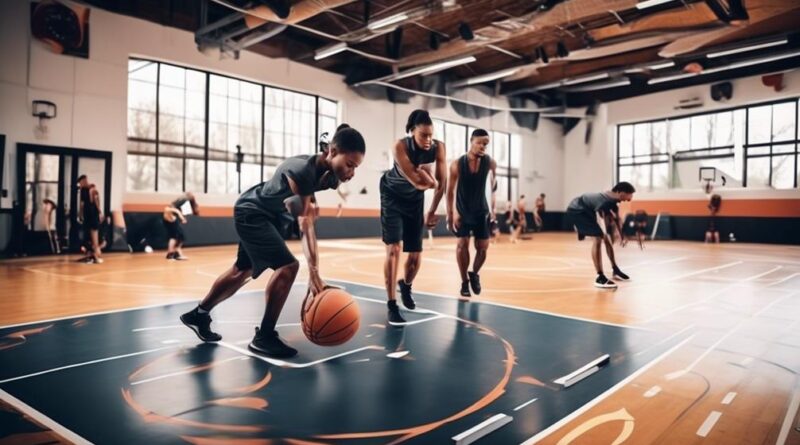Top 9 Basketball Exercises for Injury Prevention
Are you tired of being sidelined by preventable injuries? Whether you're a seasoned player or just starting out, taking care of your body is crucial for a long and successful basketball career.
You might be surprised to learn that there are specific exercises designed to target common areas of vulnerability for basketball players. These exercises not only help in preventing injuries but also improve overall performance on the court.
If you want to stay in the game and elevate your skills, it's essential to prioritize injury prevention through targeted exercises.
Dynamic Warm-Up Drills
To prepare your body for the physical demands of basketball, incorporate dynamic warm-up drills into your pre-game routine.
Dynamic warm-up exercises are crucial for injury prevention as they help to increase blood flow to the muscles, improve flexibility, and prepare your body for the movements required during the game.
Start your warm-up with light cardio exercises such as jogging or skipping to elevate your heart rate and increase circulation. This will help to loosen up your muscles and reduce the risk of strains or pulls during intense play.
Dynamic stretching exercises like leg swings, arm circles, and walking lunges are also essential to incorporate into your warm-up routine. These movements help to improve your range of motion and flexibility, which can in turn prevent injuries such as muscle strains and ligament sprains.
Incorporating dynamic warm-up drills not only reduces the risk of injury but also enhances your overall performance on the court. By priming your body for the specific movements and intensity of basketball, you're better prepared to react quickly, change direction, and jump explosively without causing harm to your muscles and joints.
Plyometric Exercises
Incorporate plyometric exercises into your basketball training regimen to improve your explosive power and agility on the court. Plyometric exercises, also known as jump training, are crucial for basketball players as they involve explosive movements that closely mimic the actions performed during a game. These exercises focus on developing fast-twitch muscle fibers, which are essential for quick bursts of energy required for jumping, sprinting, and changing directions on the court.
One effective plyometric exercise is the depth jump. To perform this exercise, stand on a box or platform, step off, and immediately upon landing, explosively jump upward. This helps to improve lower body power and reactive strength, which are essential for grabbing rebounds and challenging opponents' shots.
Another valuable plyometric exercise is the lateral bound. Begin in a semi-squat position and then explosively jump sideways as far as possible, landing on the opposite leg. This exercise enhances lateral quickness and stability, crucial for defensive maneuvers and quick changes in direction on the court.
Incorporating box jumps into your training routine is also beneficial. By jumping onto and off of a box or platform, you can enhance your vertical leap and overall lower body explosive power.
Balance and Stability Training
You can improve your basketball performance by prioritizing balance and stability training to enhance your on-court agility and resilience. Balance techniques and stability exercises are essential components of any comprehensive basketball training program. Implementing specific drills that target your balance and stability can significantly reduce the risk of injuries while enhancing your overall performance on the court.
Incorporating balance techniques such as single-leg stands, balance board exercises, and stability ball drills can help improve proprioception and coordination. These exercises challenge your body to maintain stability, which translates to better control and balance during quick movements and changes in direction on the basketball court.
Stability exercises, including planks, Russian twists, and stability ball rollouts, are crucial for developing a strong core and enhancing overall body stability. A strong and stable core is vital for withstanding physical contact, maintaining balance when driving to the basket, and executing powerful and controlled movements.
Core Strengthening Workouts
Consider focusing on core strengthening workouts to enhance your basketball performance and reduce the risk of injuries on the court. A strong core is essential for stability, power, and functional movement in basketball. Here are some core strengthening exercises that can help you improve your game and prevent injuries:
- Plank Variations: Planks are an effective way to build core stability. Include side planks and plank rotations to target different core muscles and improve overall stability.
- Russian Twists: This exercise targets the obliques and helps in developing rotational power, which is crucial for basketball movements like pivoting and shooting.
- Medicine Ball Throws: Incorporating medicine ball throws, such as overhead throws and chest passes, can enhance core strength and improve the power and accuracy of your passes and shots.
- Hollow Body Holds: This exercise not only strengthens the core but also improves body control and stability, which are essential for maintaining balance and executing precise movements on the basketball court.
Flexibility and Mobility Routines
To further improve your basketball performance and reduce the risk of injuries on the court, focus on incorporating flexibility and mobility routines that complement your core strengthening workouts.
Flexibility progressions are essential for basketball players to enhance their range of motion, allowing for fluid movements and reducing the likelihood of muscle strains. Begin with dynamic stretching exercises such as leg swings, arm circles, and hip rotations to warm up your muscles and prepare them for the demands of the game. As you progress, include static stretches that target key muscle groups used in basketball, such as the hamstrings, quadriceps, calves, and shoulders. Hold each stretch for 15-30 seconds, focusing on breathing deeply and relaxing into the stretch to improve flexibility over time.
In addition to flexibility, mobility drills play a crucial role in injury prevention and overall performance. Incorporate exercises that promote joint mobility and stability, such as lateral lunges, hip flexor stretches, and ankle mobility drills. These drills help improve your body's ability to move efficiently and maintain proper alignment during dynamic basketball movements, such as cutting, pivoting, and jumping.
Agility and Speed Drills
Enhance your basketball performance and minimize the risk of injuries by incorporating agility and speed drills into your training regimen. Agility and speed are crucial in basketball, as they allow you to swiftly change direction, accelerate, and react to the dynamic nature of the game. By focusing on footwork techniques and quickness training, you can significantly improve your on-court performance and reduce the likelihood of injury.
- Cone Drills: Set up a series of cones in various patterns and practice weaving in and out of them to improve your agility and sharpness of movement.
- Ladder Drills: Utilize a speed ladder to perform drills that enhance foot coordination, speed, and overall agility.
- Suicide Drills: Incorporate this classic basketball drill to improve your speed, agility, and conditioning by sprinting from the baseline to the free-throw line, half-court, and then the opposite free-throw line and baseline.
- Plyometric Exercises: Incorporate jumping exercises like box jumps and depth jumps to enhance explosive power, quickness, and overall athleticism.
Strength Training Regimens

Incorporating strength training regimens into your basketball routine won't only enhance your agility and speed but also contribute to injury prevention and overall performance on the court. When it comes to strength training for basketball, utilizing resistance bands can be highly beneficial. Resistance bands offer a versatile way to build strength, improve flexibility, and enhance muscle endurance, all of which are crucial for injury prevention. Incorporating resistance band exercises, such as lateral band walks, banded squats, and band pull-aparts, can help in targeting specific muscle groups essential for basketball movements like running, jumping, and shuffling.
Additionally, bodyweight exercises are another integral part of a basketball player's strength training regimen. Including exercises like squats, lunges, push-ups, and planks into your routine can help in developing functional strength and stability, which are essential for preventing common basketball-related injuries. Bodyweight exercises not only build strength but also aid in improving balance and coordination, thereby enhancing your overall performance on the court.
When designing your strength training regimen, it's crucial to focus on exercises that target the muscles involved in basketball-specific movements. Incorporating a combination of resistance band and bodyweight exercises into your routine can help in developing a strong foundation, thereby reducing the risk of injuries while improving your agility, speed, and overall basketball performance.
Injury-Specific Prevention Exercises
Consider performing targeted exercises that focus on strengthening specific muscle groups to prevent common basketball-related injuries. Injury-specific techniques and rehabilitation strategies can be valuable in preventing injuries and improving overall performance on the court.
Here are some exercises that can help you target key areas prone to basketball-related injuries:
- Ankle Stability Drills: Incorporate exercises such as ankle circles, alphabet drills, and single-leg balance exercises to improve ankle stability and reduce the risk of ankle sprains, which are common in basketball.
- Rotator Cuff Strengthening: Perform exercises like external rotations with resistance bands and dumbbell internal and external rotations to strengthen the rotator cuff muscles, reducing the risk of shoulder injuries often associated with shooting and passing.
- Core Strengthening: Engage in planks, Russian twists, and medicine ball exercises to strengthen the core muscles, which can help improve stability, balance, and reduce the risk of lower back injuries.
- Jumping and Landing Techniques: Practice proper jumping and landing mechanics to reduce the risk of knee injuries. Focus on soft landings, bending the knees upon landing, and strengthening exercises like squats and lunges.
Frequently Asked Questions
What Are the Most Common Types of Basketball Injuries and How Can These Exercises Help Prevent Them?
To prevent common basketball injuries and improve performance, incorporate exercises targeting the knees, ankles, and shoulders. Strengthening and flexibility exercises, along with proper warm-ups, can help reduce the risk of injury and enhance your basketball performance.
Are There Any Specific Exercises or Modifications for Older or Less Experienced Players to Prevent Injury?
For older or less experienced players, you can modify exercises to match their age and skill level. Adjust equipment and consider safety measures to prevent injuries. Always prioritize proper warm-up and cool-down routines.
Can These Exercises Also Help Improve Overall Basketball Performance, or Are They Mainly for Injury Prevention?
Yes, these exercises can improve overall basketball performance. By incorporating exercise modifications, recovery strategies, and mental preparation, you can enhance agility, strength, and endurance. This comprehensive approach benefits both injury prevention and performance enhancement.
How Often Should These Exercises Be Incorporated Into a Basketball Player's Training Routine?
You should incorporate these exercises into your training routine regularly to prevent injuries and improve performance. Modify your training routine to include these exercises at least 2-3 times per week to see the best results.
Are There Any Specific Exercises or Modifications for Players With Previous Injuries or Chronic Pain?
To manage chronic pain and previous injuries in basketball, focus on specific exercises modifications. Tailor your routine to accommodate your condition. Consult a professional for personalized advice and adjustments to ensure safe and effective chronic pain management.
Conclusion
So there you have it, the top 9 basketball exercises for injury prevention.
By incorporating these drills and workouts into your training routine, you can improve your strength, agility, and stability on the court while reducing your risk of injury.
Remember to always warm up properly, listen to your body, and consult with a trainer or medical professional if you have any concerns.
Stay safe, stay strong, and keep playing the game you love!
